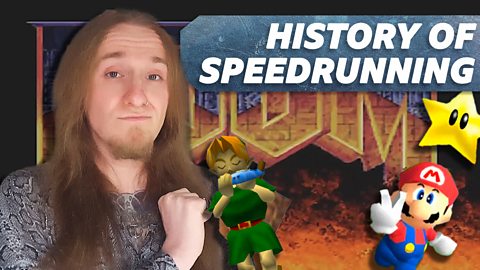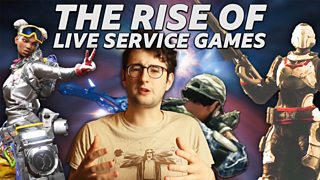Speedrunning: A brief history of the gaming phenomenon
By Andy McDonald // 大象传媒 The Social contributor
Since the early days of the medium, speed is something that’s been rewarded in video gaming.
Two of its most well-known icons have it woven into their gameplay; the original Super Mario Bros series added your remaining time to your score upon reaching the end of a level, encouraging faster playthroughs, while Sonic the Hedgehog was even born from co-creator Yuji Naka’s attempts to race through Mario’s first level as quickly as possible.

A BRIEF HISTORY OF SPEEDRUNNING
Speedrunning has blown up as a scene in the last few years.
Much like real-life track and field, a certain section of gaming has come to be based around agility; alongside the rise of e-sports - a huge industry centred around public, competitive gameplay - a phenomenon known as speedrunning has emerged, in which players post their quickest times for getting to the end credits of a game. It’s something that’s resonated with gaming fans around the globe, giving rise to wildly popular YouTube channels, charity events and groups who promote the practice.
A speedrun is a completely different beast. In some cases, you get to see a game totally broken apart with glitches to cut down on time.
“There’s the element of the world record - it’s easy to understand why people would want to see something done at a speed that has never been done before.” says Matt Harris of the UK Speedrunning Marathon, one such organisation. “Why do people get excited about someone running 100 metres really quickly? It’s the same with speedrunning - only now in the form of completing a video game really quickly.”
The worldwide speedrunning scene boasts hundreds upon thousands of players unified by a drive to tear through titles in the space of minutes or hours. No sooner is a world record completion time posted than others are scrambling to one-up it. So why has speedrunning captured the hearts of so many?
Perhaps it’s to do with the age-old romanticisation of being able to cheat a video game, something that was a common playground bragging right. I can still instinctively skip to the last world of Super Mario Bros 3 in a matter of minutes using sleekit tactics I learned two decades ago, but pixelated parkour like this is now being utilised in a larger context to make epic adventures look like cakewalks.

Nintendo’s greatest story ever told - The Legend of Zelda: Ocarina of Time - has recently been reduced from a sprawling odyssey to a sub-eight-minute exploitation of mechanics that warps you from the introductory area to the end credits, all in the name of competition and entertainment.
People who may never have been exposed to speedrunning before were watching the games that they love being played incredibly quickly. They loved it, they ate it up.
“I think it’s the spectacle,” ponders Matt. “Most people play a game once, twice, maybe, if they enjoy it, and then they never play it again. Alternatively, they might watch a casual playthrough on YouTube or Twitch. A speedrun is a completely different beast. In some cases, you get to see a game totally broken apart with glitches to cut down on time. In other cases, you just get to see some play segments of a game incredibly precisely and incredibly well done to get things done quickly. It’s a showcase of raw talent and raw skill.”
Whatever the case, it’s a scene that’s as collaborative as it is competitive; the definitive symbols of speedrunning are the aforementioned marathons in which players congregate to blast through games before a pledging audience, whose support has, to date, raised millions for charity. The American event series Game Done Quick is at the forefront of this global sensation, having garnered almost $26 million for the likes of cancer prevention and Doctors Without Borders over the last ten years.

Gaming for a good cause has also made it to our shores, with the likes of Quickcade and the UK Speedrunner Gathering having raised thousands for the Wings For Life and YoungMinds charities. The aforementioned UKSM, meanwhile, have been invited to some of the nation’s biggest gaming expos including Insomnia and EGX to showcase the talents of Britain’s speedrunners while raising thousands for Doctors Without Borders and, more recently, gaming and tech charity SpecialEffect. And although some forthcoming events have been moved to online platforms due to the ongoing coronavirus pandemic, the organisers believe that the audience and appetite for speedrunning in the UK continues to grow.
“There are a lot of people in the UK that speedrun all sorts of games, so I am confident in saying that it’s vibrant, but still growing. Truly, the variety of games in the UK scene is huge.” says Paul Lambropoulos of UKSG. “Attendance has been steadily increasing, so I think we’re on a good track.”
“The UK speedrunning scene is something that I think is truly incredible,” echoes Matt. “UKSM proved that the community was there and it wasn’t being catered for. The UK speedrunning scene has only just begun. When it comes to the future of the scene in the UK and whether it will continue to grow or not, I just have to look back on our EGX event. We had a massive stage, we had a ton of seats, and they were pretty much all filled throughout the whole event - people who may never have been exposed to speedrunning before watching the games that they love being played incredibly quickly. They loved it, they ate it up, and that can only mean the community is going to expand in the future. That’s the dream, anyway.”




